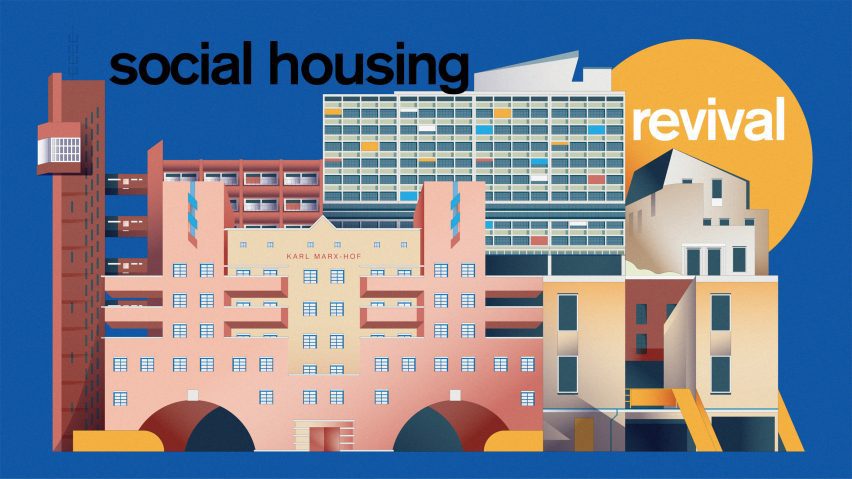The world is suffering from a housing-affordability crisis. Dezeen's new series will explore the Social Housing Revival, and celebrate the best contemporary social housing around the globe.
Last week, the UK Government revealed that at the most recent count, 109,000 households in England were legally homeless – a 10 per cent rise on a year before – while rough sleeping is 120 per cent more prevalent than it was in 2010.
These are but the latest in a long, long line of dismaying statistics about the suffocating housing-affordability crisis being experienced by people across the planet, particularly in major cities.
From London to New York, Dublin to Taipei, Lagos to Toronto, Sydney to San Francisco and many more places besides, a comfortable, affordable, secure home is simply out of reach for much of the population.
A solution from the past
The consequences of this global crisis are profound. Poor quality, unaffordable housing is linked to physical and mental health problems, falling fertility rates, bad educational outcomes, civic discontent and inhibited economic growth. A growing number of commentators are even talking about "the housing theory of everything": the idea that the ripple effects stemming from a lack of affordable homes makes everything worse, for everyone.
It's a complex problem and opinions about the most significant root causes vary. Some point to population growth and urbanisation driving demand, others to a lack of new development due to planning laws perceived as overly restrictive.
Former UN special rapporteur on adequate housing Leilani Fahra blames what she calls the "financialization" of housing – the phenomenon whereby homes have increasingly been treated primarily as investment assets, including by some of the world's largest corporations. The total value of global residential real estate is now close to $300 trillion – around three times more than global GDP.
Also varied are ideas about the most effective solutions. Should we find a way to eradicate NIMBYism? Build new cities? Work out how to design homes more cheaply? Overhaul planning systems? Upgrade housing-subsidy programmes?
In this series, we will be exploring a solution that many governments reached for in the past: social housing.
Almost every nation has its own social-housing story. In the UK, for example, it's common to hear wistful talk of the two post-war golden eras of council housing, abruptly ended in the 1980s by Margaret Thatcher's government.
But in the US, where the televised images of the Pruitt-Igoe towers being demolished are still burned into the collective memory, public housing is often seen as a failed endeavour, associated mainly with crime and delinquency.
Meanwhile, in Singapore, living in public housing is the norm, with four-fifths of the population counting the government as their freeholder or landlord. Then there's Vienna – the global capital of housing affordability, and a touchstone for the benefits of sustained investment social housing.
Other countries are in the early chapters. Brazil, Ethiopia and Taiwan are among many more that have recently embarked on ambitious state-backed house-building programmes, with varying degrees of success.
Celebrating the hidden gems
We will attempt to tell as many of these stories as possible, focusing particularly on the past 15 years – the period since the global economic crisis of the late noughties which came to accelerate the housing-affordability issues that had already been brewing around the world.
This will involve highlighting some of the best and most interesting social housing built in that time, including some hidden gems, and profiling cities that are taking unusual approaches. It will mean delving into the major issues underpinning social housing with the help of expert voices.
Why now? Partly because 2024 is the biggest election year in history, and social housing is highly political. As the cost-of-living crisis tips more and more people into financial distress, we can expect housing to become a key battleground. Already we have seen unions in the US identify it as their number-one issue, while the UK's government mulls ways to turn its abysmal record on social housebuilding to its electoral advantage.
Also, because against the backdrop of worsening housing affordability, a quiet renaissance has been gaining momentum in pockets of the globe. We are moving back to a time when some of the most exciting architects around are doing their best work on social housing – coining a whole new tradition of beautiful, sustainable, community-fostering homes that are affordable to everyone.
We call it the Social Housing Revival.
The illustration is by Jack Bedford.
Social Housing Revival
This article is part of Dezeen's Social Housing Revival series exploring the new wave of quality social housing being built around the world, and asking whether a return to social house-building at scale can help solve affordability issues and homelessness in our major cities.

